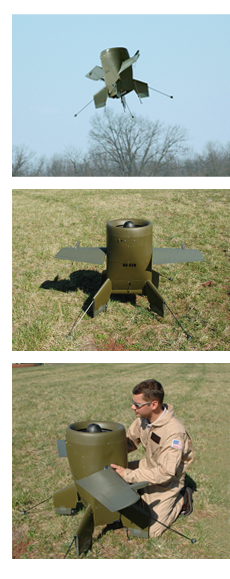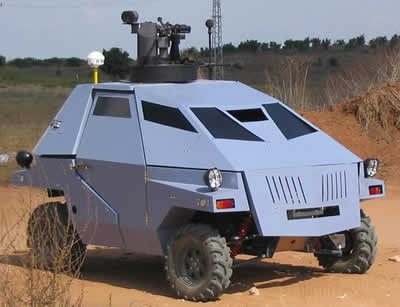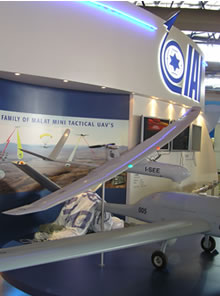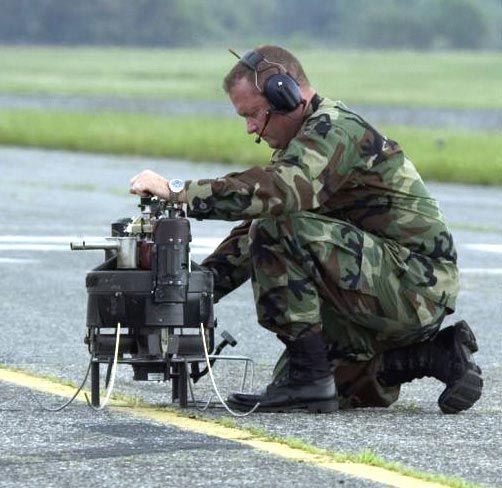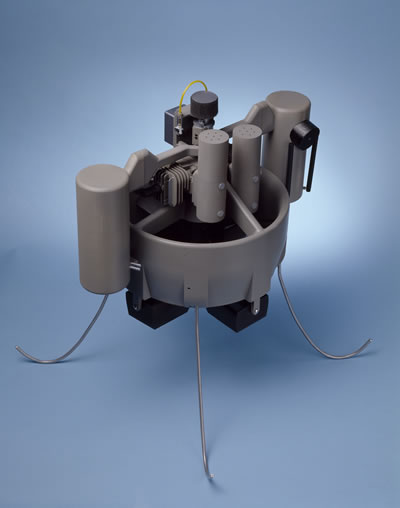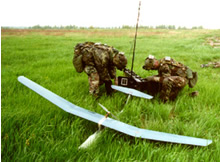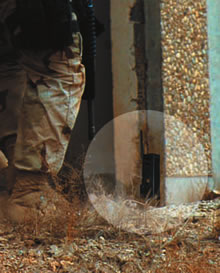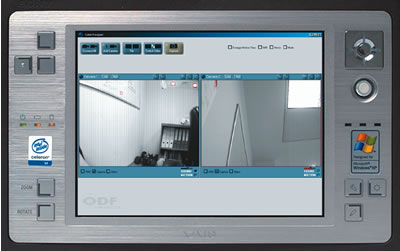The very fact, that all three of these phenomens have occured almost simultaneousely, has placed the Iranian regime under considerable stress, searching for ways to overcome internal and external threats to its survival. Furthermore, the growing presence of American military forces, could block Iran’s political aspirations to become the leading military power in the post-Saddam Gulf region.
The rulers in Tehran fear, that they could become next on President Bush’s target list, once the situation in Iraq stabilises sufficiently to enable determined action against what the president named “axis of evil”, with Iran’s Islamic fundamentalist regime now heading the list in the region.
Having waged a full scale war during the Eighties against Saddam Hussein’s overwhelming military power, the Ayathollas closely followed the new American warfighting methods used in 1991 and 2003 against Saddam Hussein’s Iraq, fully realising that, under the new strategic circumstances, only a determined effort to create a non-conventional national deterrent could save the Iranian regime from a similar fate. Indeed, one of the major lessons from Operation Desert Storm was that, should Saddam Hussein have deployed a substantial WMD threat in August 1990, it is doubtful wether a US contingency force deployment could have taken place without facing mortal danger. During the six months which Operation Desert Shield required in order to mass half a million troops in Saudi Arabia, all would have been within high-risk range of lethal weapons.
Thus the race for weapons of mass destruction is on in Tehran these days, not only to threaten Israel, the “little Satan”, but actually save the Shi’ite revolutionary regime from extinction by the “big Satan”, the United States and its allies.
There are three fields of WMD activities, chemical, biological and nuclear, in which Iran has been extremely busy over the last decade or so. Furthermore, impressive advances in the development of long range delivery platforms, have already placed Iran in the forefront of regional threats against its neighbours, including the US military deployment in the region.
The aim of this article is to examine Iran’s biological weapons program.
The Background of Iran’s Biological Warfare Program
Efforts to establish a biological weapons deterrent started in Iran during the mid-Eighties, after Saddam Hussein’s forces fired 200 Scud missiles against targets in Tehran and other cities, causing a mass exodus from the Iranian capital, after rumours spread that some of the missiles carrying poison gas. In response, the clerical regime started its own chemical, bacteriological and radiological weapons program, clearly realising that only a determined effort in this field could avert a future disaster from occuring, once hostilities in the region would resume.
One of the first research facilities established in 1986 under the new program was the Tehran based Pasteur Institute, which started to work on the development of toxic fungus and microbiological substances. During its first stages, the center concentrated on producing aflatoxin, a potent natural mycotoxin produced by aspergillus flavus, which can be weaponised by certain biochemical procedures.
At the same time similar research was undertaken at the Vira Laboratory Shari’ati under Dr Gholamhossein Riazi.
A 1989 US intelligence report mentioned Iranian agents trying to buy two new strains of fungi, Fusarium from Canada and the Netherlands that can be used to produce T-2 mycotoxins. The Imam Reza Medical Center at Mashhad Medical Sciences University and the Iranian Research Organization for Science and Technology were ostensibly identified as the end users for this purchasing effort, “but more likely was that the true end user was an Iranian government agency specializing in biological warfare.” Until the early nineties, Iran’s bacteriological activities, were limited to scientific research, as well as initial studies in CB warfare. However, due to the extensive biological infrastructure, which existed in Iran already for decades, the way towards biological warfare was clear once a political decision was reached. This happened soon after Operation Desert Storm in 1991, when the Iranian leadership realised the rapid victory over Saddam Hussein’s military might, by the US led coalition. The effect in Tehran was overwhelming. A far-reaching re-orientation of its own military capabilities resulted in a decision to develop weapons of mass destruction with chemical and biological weapons being in the immediate forefront of a large scale development program.
Willing help was not difficult to find in the early nineties. The former Soviet Union had disappeared as a global power, but its decade long efforts in development and production of WMD were well known to the unscupulous Ayathollas, their affluent reserves in Petrodollars presenting ideal attractions to thousands of unemployed Russian scientists looking for clients, appreciating their knowledge in weaponsing deadly toxins. Dr Kenneth Alibek ( aka Kanatjan Alibekov), a former chief scientist and first deputy director of Biopreparat a highly secret organisation established in Russia in 1973, defected in 1992 to the US. Ostensibly a state-owned pharmaceutical facility, Biopreparat developing drugs and vaccines, it was in fact was a front for the USSR’s secret offensive bio weapons programme, employing thousands of skilled workers. According to Alibek, even the KGB maintained its own secret biological weapons research, codenamed Flayta, developing bacteriological toxin substances for its notorious Speznaz special forces, including cultivating the deadly Marburg virus into weaponised substance.
Other Russian defectors reports, released by the CIA and other western intelligence agencies, indicate that Soviet military biologists worked on the weaponisation of over 50 disease agents, testing some of these on Vozrozhdeniye Island in the Aral sea. Among the bacteria were highly effective toxic substances such as plague, tularemia and new classes of so-called “biolregulators”, aimed to modify human emotions, heart rhythm patterns, affecting front line troops. Research was also carried out in genetic structure engineering, making known pathogens resistant to antibiotics.
These disciplines are of particular interest to third world rogue terrorist organisations, through its capability in destroying crops, affect humans etc. Sources claim, that leading Russian scientists have been approached by Iranian agents wishing to obtain the principles of genetic engineering in microbiology.
Some of this scientific knowledge and experience can be bought for hard cash.
Unconfirmed, but seemingly reliable information on this activity was provided by Iranian opposition groups indicating that a certain brigadier general Mohammed Fa’ezi is responsible with recruiting foreign scientists.
According to recently declassified intelligence reports, a suprise visit in 1997 to a former highly secret Soviet BW plant found a half-empty facility protected only by a handful of bored guards. No one knew where the scientists have gone. Some of them are believed already working in Iran. In January 1999, the Moscow daily Kommersant reported that in 1998 Anatoly Makarov director of the All-Russia Scientific Research Institute led a delegation to Tehran and gave the Iranians information related to the use of plant pathogens to destroy crops.
The London Sunday times reported in August 1995 that “by hiring Russian BW experts, Iran had made a “quantum leap forward” in its biological weapons development program. According to the New York Times, many of the contacts were made with former Biopreparat scientists through one Mehdi Rezayat, identified as key figure in a world wide Iranian aquisition network. An Iranian opposition group revealed earlier this year, that in 2001 Iran has begun a top secret biowarfare project, aiming to triple the size of its WMD arsenal, based on an ambitious document named ” Comprehensive National Microbial Defense Plan”, approved by the Supreme National Security Council.
According to latest intelligence reports, Iran has started production of weaponised anthrax spores, and is investigating efforts in other pathogens, including smallpox for its bioweapons arsenal. It is of interest, that Kenneth Alibek supervised the development of weapons grade smallpox during his tenure as scientific chief at Biopreparat, so that the knowhow would be still available for lucrative cross-border sales.
The Iranian BioWeapons Development Infrastructure Potential
Some of the most common agents that are associated with the Iranian BW program are Bacillus anthracis (anthrax), botulinum toxin, ricin, T-2 mycotoxin, and Variola virus and the causative agent of smallpox.
The many sophisticated research facilities in Iran could easily serve as a front for illicit BW-related activities and could offer a legitimate excuse to import dual-use material.
The Pasteur Institute
69 Pasteur Avenue Tehran
Located at the Iranian Science Center for Biotechnology and Molecular Biology.
Established in 1920 as a primary center for research of infectious desease and production of biological vaccines.The Biotechnology Department was formed in 1993 as a modern genetic engineering research institute.
According to intelligence reports, the Defence Ministry operates a secret experimental laboratory within the institute, studying toxic fungus, specialising in aflatoxin. A special MOD official supervises the work on biological agents.
Heading the institute is Dr Mortez Azartush, who denied 1999 reports that illegal activities are taking place at the Pasteur Institute.
The Vira Laboratory
Shari’ati Street Tehran
Also known under the name of Sina Industries it operates ostensibly focusing on agriculture and medical research, but actually its main function seems to be as the chemical laboratory of the Defence Ministry Special Industries Organisation. It functions as research center for testing and production of chemical and biological warfare-related substances. Several reports mention Vira having field tested biological agents on animals.
Heading the laboratories during the nineties was Dr Gholamhossein Riazi, a specialist in biological fermentation process.
His deputy, Dr Yousefi is now in charge.
Special Industries Organisation ( Ministry of Defence)
Gostaresh Research Center Tehran ( Zartosht Street?)
Formed in 1999 ( some reports mention an earlier date as 1993) to develop chemical weapons. The SIO supervises and coordinates various scientific programs, including biological research, with a special branch studying and developing biological weapon grade bacterial agents.
Intelligence reports, probably based on internal HUMINT indicate the location of a special facility related to SIO being camouflaged from sight along the Tehran-Karaj highway, known locally as Shahid Meysami Industry. Apparently this site also acts as storage depot for chemical (and biological?) artillery shells for the Revolutionary Guards units. Some years ago, rumours spread, that lax safety procedures caused severe health hazards to workers employed there.
The Nuclear Threat Initiative (NTI) website has published some interesting details on SIO activities in its Country Information on Iran:
“Two Swiss firms, Bio Engineering (a subsidiary of Bayer AG) and MBR Company, had been selling fermenters to Iran in the 1990s that were claimed to be entirely for civilian use. Company officials insisted that the Iranian purchasers were the Ministry of Agriculture and an entity they identified as MIDSPGIC Co. However, the People’s Mujahadin of Iran claimed that MIDSPGIC is an abbreviation for the Special Industries Organization of the Defense Ministry. Bio Engineering was attacked two times in 1992, once at its office outside of Zurich (apparently by a terrorist group) and once at its Munich-based delivery company. Equipment destroyed in the attacks included a 15-liter lab fermenter and a 750 production fermenter, similar to those used by Iraq for its BW program.” (NTI August 2003)
Iranian Revolutionary Guard Corps Imam Hussein UniversityLocated in Tehran, the university complex houses extensive, but highly secret research departments led by scientists, members of the Iranian Revolutionary Guard Corps (IRGC) or Pasdaran. According to reports, this establishment focuses on weaponisation of several biological agents, including anthrax, smallpox, typhoid, plague and cholera bacteria. IRGC scientists also engage in weapons-related genetic engineering research at the Malek Ashtar University, Shahinshahr,based in the Lavizan Shian Technological Research Center and headed by Dr Maqsudi, who is in charge of the affiliated center for Scientific and Growth Technology. Dr Hossein San’ati heads this center and has been active in this field since the eighties. Jointly with Dr Mirza’i and Karami, the team became known as architects of the national microbial weapons research project.
Experiments have been taken place at the IRGC Imam University, testing of microbial bombs using anthrax, smallpox, typhoid fever, as well as high dosage aflatoxin.
The authorities have placed substantial effort in coordinating all these functions, by establishing a new department named Directorate to Asess Weapons of Mass Destruction, which also focuses on recruiting foreign WMD related advanced technologies in biochemistry. This diretorate also supervises activities in acquisition, training and supplying various special forces with bioweapon related technologies.
A special organisation in the Ministry of Defence is charged with Chemical, Biological and Nuclear industries to supervise all production activities, headed by Brigadier General Seyyedi.
Heading the new directorate is Brigadier General Nasser Toqyani, a senior IRGC commander. His superior is Major General Hassan Firouzabadi chairman of the Joint Command HQ of the IRGC. In charge of microbiological weapons development section is Brigadier General Abroumand.
Other Biological Facilities related to BioWeapons Program
Biological Research Center of SIO
located at Shahid Meisami Martyr Complex Special Karaj Highway
Revolutionary Guards Baqiyatolla Research Center
affiliated to the Guard’s Baqiyatolla hospital works under Dr Karami, an experienced member of the IRGC Imam Hussein University scientific staff in the study and development of biological weapons.
Damghan Weapons Production Facility
located near a dry lake approximately 375 miles to the southwest of Mashad, or 300km east of Teheran.
Unconfirmed reports indicate that Damghan is the site of a biological weapons research laboratory constructed with Russian assistance.
Other facilities who could be, or become related to the production of biochemical weapons grade material are widely dispersed in almost all major Iranian cities.
There are also numerous research institutions, in which various dual related biological studies could take place. Among the major “civilian” institutes are:
Biotechnology Research Center, Group of Fermentation and Biological Technology
No.71 Forsat St.,
Ferdowsi Square
Tehran
National Center for Genetic Engineering and Biotechnology Research
No. 15,
Abbas Shafiee Alley,
Quds St.,
Inqilah Ave.
Tehran
Sharif University of Technology
Biochemical and Bioenvironmental Research Center
Tehran
The Institute of Biochemistry and Biophysics (IBB)
University of Tehran
Note
Most of the information for this part was supplied by the National Council of Resistance of Iran (NCRI) early 2003.
There are conflicting attitudes over the reliabity of the NCRI reports, mainly due to the US State Department statement on August 15 naming the NCRI as affiliate to the Mujahidin-e-Khalq (MEK) terrorist organisation, which leaders of the NCRI denied vehemently.
As there is no concrete mechanism for verifying government reports or allegations from exile groups, so many of the allegations regarding the Iranian BW program remain unsubstantiated. However, according to reliable intelligence assessment sources, some of the NCRI reports have been verified by satellite and HUMINT, including their exposure on December 2002 revealing the Iranian secret uranium enrichment site at Natanz, which was verified by Dr Mohamed ElBaradei of the International Atomic Energy Agency.
The NTI website and GlobalSecurity, and other intelligence assessment agencies,
frequently quote NCRI sources in their news updates.


